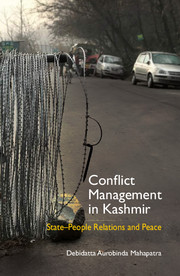Book contents
- Frontmatter
- Contents
- Preface
- Chapter 1 Kashmir, Conflict and the (Uncomfortable?) Questions
- Chapter 2 Theorizing Conflicts
- Chapter 3 Protracted Social Conflict in Kashmir
- Chapter 4 Peace Process, Cross-border Opening and the Engagement
- Chapter 5 Traders’ Perspectives
- Chapter 6 Policymakers’ Perspectives
- Chapter 7 Conflict Management Prospects
- Select Bibliography
- Index
Chapter 1 - Kashmir, Conflict and the (Uncomfortable?) Questions
Published online by Cambridge University Press: 01 August 2019
- Frontmatter
- Contents
- Preface
- Chapter 1 Kashmir, Conflict and the (Uncomfortable?) Questions
- Chapter 2 Theorizing Conflicts
- Chapter 3 Protracted Social Conflict in Kashmir
- Chapter 4 Peace Process, Cross-border Opening and the Engagement
- Chapter 5 Traders’ Perspectives
- Chapter 6 Policymakers’ Perspectives
- Chapter 7 Conflict Management Prospects
- Select Bibliography
- Index
Summary
Violence, deprivation and protracted conflicts are linked and are among the most pressing problems human society confronts today. It is crucial to address them to realize a peaceful and secure world. In this book, I examine them and explore prospects of conflict transformation by focusing on one of the world's most complex conflicts – Kashmir. I examine the prospects of managing the vertical aspect of this conflict, in which the Indian state and the marginalized Kashmiris are engaged in a conflictual relationship. Broadly, my goal is twofold: to apply a protracted social conflict (PSC) framework in understanding the Kashmir conflict, and to suggest ways to address it.
I have been working on the Kashmir conflict for over a decade. The sustained research has helped me grow personally and professionally. From a personal standpoint, I have become empathetic to the people's everyday struggle to lead a normal life amidst violence. Professionally, I have explored various aspects of the Kashmir conflict. My initial writings attempted to understand Kashmir from a foreign policy perspective. My interactions with the Kashmiris propelled me to look at the problem from the people's perspective. I then explored the internal dimension of the conflict. I documented how the sustained militant movement challenged efforts at managing the conflictual relationship shared by the state and the people. I explored how defective policies paved the way for internal conflict. I have been ruminating on this work for over a decade as several questions troubled me. More so, the humanitarian consequences of violence, traces of which I have witnessed during my residence and field surveys in the region, strengthened my resolve to work on this particular subject – how to address the conflict. This book, hence, is not a mere academic exercise; it is also an attempt to look for alternatives, for solutions.
Reality Check
Why some groups within a state feel alienated and adopt violent methods to fulfill their needs, and how a violent conflictual relationship between a state and a group can be managed, have emerged as critical issues in the twentyfirst century with resonance throughout the modern world, in which intrastate conflicts have far surpassed interstate conflicts. Micro-level approaches in managing an internal conflict through an intensive engagement of a state and its people in a cooperative framework may prove more sustainable than grand theorizing.
- Type
- Chapter
- Information
- Conflict Management in KashmirState–People Relations and Peace, pp. 1 - 18Publisher: Cambridge University PressPrint publication year: 2017

